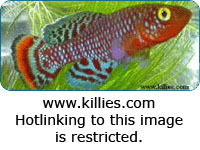| To rig up your own brine shrimp hatchery, these are the items you will need - A 1.5 litre plastic bottle (preferably, one with many ribs and grooves on its sides), a one-way gang valve, a bit of string and an air pump. | |
|
|
Cut
off the bottom one-third of the plastic bottle. Use a sharp object to
make a small hole in the cap and then force the one-way gang valve through
it. It won't leak and you don't have to use silicon if the size of the
hole is slightly smaller than the gang valve. Punch 2 holes at the other
end of the plastic bottle and pass the strings through them. Fill the
bottle with water and check for leaks.
|
|
To hatch brine shrimp eggs, fill up the hatchery with about one litre of water. Add one tablespoon of salt and a small scoop of brine shrimp eggs. Connect the valve to an air pump and aerate the solution for 24 hours. The solution should turn a bright red colour, indicating that most, if not all, the eggs have hatched. Do not use kitchen salt or the hatch rate will be very low. Many fish shops in Singapore sell brine shrimp eggs that will NEVER hatch no matter how long you aerate them. I think this is because they are not keeping their eggs in the proper conditions. Brine shrimp eggs should always be kept in the referigerator (in the vegetable compartment, not in the freezer) when not in use. |
|
|
|
To
harvest the baby brine shrimps, close the gang valve and add half a
litre of tap water to the hatchery. Disconnect the tubing and wait for
5 minutes. If all goes well, 3 layers will form in the solution. Egg
shells will form the top layer; clear water will be in the middle layer
and the baby brine shrimps will congregate at the lower one-third of
the solution.
|
|
Release the gang-valve and let the solution flow into a bottle. As the water level in the hatchery drops, the egg shells stick to the sides of the bottle and voila, what comes out through the gang valve are pure baby brine shirmps. |
|
|
|
You can either use a turkey baster or a brine shrimp net to feed your fish with the baby brine shrimps. I find it's better to use a turkey baster as dipping a net into one tank after another is a sure-fire way to contaminate every tank if one is diseased. The nutritional value of baby brine shrimps drops dramatically a few hours after hatching. So do not leave your baby brine shrimps in the hatchery for too long. If possible, feed them to your fish as soon as they hatch. |
